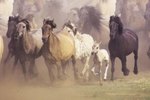
Mules are hybrid animals resulting from the crossbreeding of a horse mother and a donkey father. While it's possible for horses and donkeys to breed in the wild, the vast majority of mules have been created by humans through selective breeding. Mules have been human companions for millennia, highly valued for their unique physical traits and amiable personalities.
Origin of Mules
Where the two animal types coexist in the same habitat, it's possible for horses and donkeys to breed in the wild to produce mules. This happens rarely, however, and nearly all the mules humans use they bred themselves. Humans have bred mules for thousands of years. According to the American Mule Museum, the ancient people of Paphlagonia and Nicaea, a region now within north and northwestern Turkey, were the first to breed mules. Heiroglyphic records indicate that the ancient Egyptians used mules as their preferred pack animals over camels. In many ancient Mediterranean, European and Middle Eastern cultures, mules were considered a much more valuable animal than horses or donkeys and were often reserved as the steed of royalty. Christopher Columbus is credited with breeding mules for the first time in the New World. Since then they've been used throughout North America for a variety of purposes.
Purpose of Mules
Mules help humans with lots of jobs just like horses and donkeys do. They can serve as steeds, carry loads and compete in shows. Mules often offer more years of lifetime service than horses. They may be seen as stubborn, but this is because mules aren't willing to overwork themselves the same way horses do. Mules are also considered to be highly intelligent animals. Parents for a mule are chosen based on the offsprings' intended purposes. The mother horse determines the mule's size, the length of its stride, his jumping ability and his physical endurance. A mule's intelligence, easy care, sure-footedness and longevity are credited to his donkey father.
Related Hybrids
Specific names are given to the offspring of a horse and a donkey depending on the gender of each parent. Mules result from a female horse mating with a male donkey. A hinny is a male mule resulting from the pairing of a female donkey and a male horse. A molly is a female mule resulting from a female donkey and a male horse. Draft mules are bred from draft mare horses coupled with male donkeys. Mules that are 3 feet tall or shorter at their withers are considered miniature mules.
Why Mules and Hinnies Are Sterile
Mules and hinnies aren't able to breed to create more mules because they don't produce sex cells in their gonads. Horses have 64 chromosomes and donkeys have 62. So a mule receives 32 chromosomes from its horse parent and 31 from its donkey parent. Because horses and donkeys have different numbers of chromosomes, and their chromosomes don't match exactly, their mule offspring don't properly produce sex cells during meiosis. Meiosis is the process in which sex cells are made in an animal. Non-sex cells are produced via mitosis (cell division), which the mule's chromosomes have no trouble doing. In a few very rare cases, female mules have given birth to foals. However, no cases have been reported of a male mule fathering a foal. The ancient Roman saying, "When a mule foals," is equivalent to the modern saying, "Once in a blue moon."
References
Resources
Photo Credits
-
Medioimages/Photodisc/Photodisc/Getty Images
Writer Bio
Madeline Masters works as a dog walker and professional writer. In the past she has worked as a fitness columnist, fundraising copywriter and news reporter. Masters won two Pennsylvania Newspaper Association Awards in 2009. She graduated from Elizabethtown College with a Bachelor of Arts in English.


